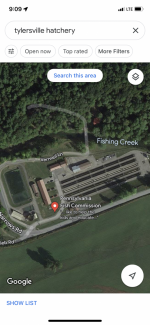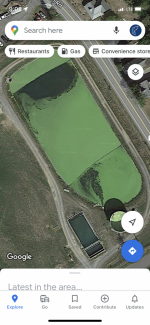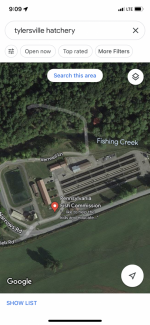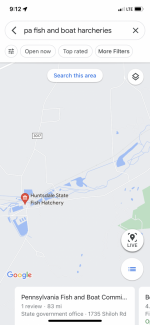The Bucks Co involved a spring that is much larger than most feeding ponds in Pa. The spring and the surrounding property was owned by the PFC and then the PFBC for decades and was originally acquired with the idea of possibly creating an eastern trout hatchery. Volumes of spring water required for a sizable hatchery are a lot greater than the flow from most spring ponds in Pa. Plus, that spring is a limestoner. Given the volume of cold water, success of trout reintroduction was not a big surprise. Given the limited habitat/shallow nature of the stream where substrate is suitable for ST, the stream is unlikely to produce more than a low density number of ST of legal size although in time the density of smaller fish could be high. I wouldn’t look at this case and say with any kind of authority that this is what could be accomplished elsewhere in Pa if only the spring ponds could be drained.
The typical degradation that I have seen all over SE Pa of water temps in wild trout streams by ponds comes from the cumulative effects of multiple ponds discharging to a stream, but even then it is typical that a stream is unshaded in those areas where the ponds begin and downstream.
Low head dams warming wild trout stream water temps are another separate but related problem and some of these are being gradually addressed by the PFBC in concert with other agencies, such as DEP and the ACOE, American Rivers, and sometimes a TU Chapter and/or a nature conservancy. I would emphasize that some of these dam removal projects are specifically wild trout related, although clearly other species benefit….sometimes American eels, sometimes sea lampreys (Cooks Ck, Bucks Co for example, a Class A BT stream), and often white suckers, etc. There is more of this going on behind the scenes than you will probably ever know and at times the opposition is fierce, yet the work often still gets done. Beginning to end can take years.
The typical degradation that I have seen all over SE Pa of water temps in wild trout streams by ponds comes from the cumulative effects of multiple ponds discharging to a stream, but even then it is typical that a stream is unshaded in those areas where the ponds begin and downstream.
Low head dams warming wild trout stream water temps are another separate but related problem and some of these are being gradually addressed by the PFBC in concert with other agencies, such as DEP and the ACOE, American Rivers, and sometimes a TU Chapter and/or a nature conservancy. I would emphasize that some of these dam removal projects are specifically wild trout related, although clearly other species benefit….sometimes American eels, sometimes sea lampreys (Cooks Ck, Bucks Co for example, a Class A BT stream), and often white suckers, etc. There is more of this going on behind the scenes than you will probably ever know and at times the opposition is fierce, yet the work often still gets done. Beginning to end can take years.
Last edited:










